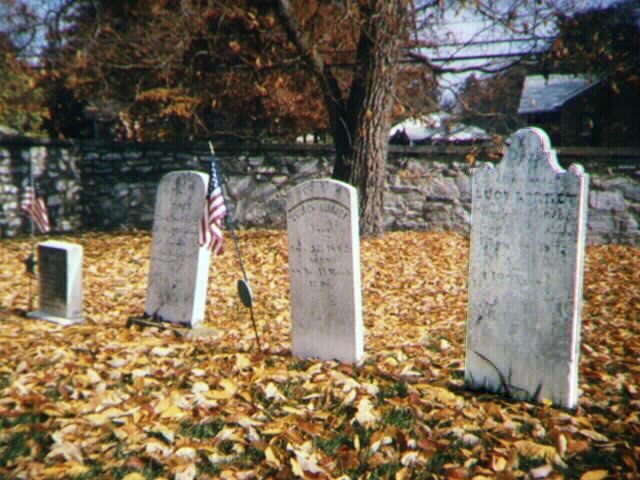Burials in Paxton Presbyterian Church Cemetery

The tombstones of Dinah, George Lorrett and Lucy Lorrett in Paxton Presbyterian Church Cemetery, Harrisburg, Pennsylvania. |
From left to right, the graves are for "Dinah," a former slave of the Cowden family,
George Lorrett, and Lucy Lorrett, George's mother. Former slaves were welcomed into the church's congregation and several worshipped there regularly, according to a 1976 published history of the church. On Dinah the book notes:
She was a jolly, friendly person who was beloved by everyone who knew her. When funeral services were held for Dinah in the Church it is reported that more carriages were here for her funeral than were present at the funeral of any white person for many and many a year.
The book also identifies George Lorrett as Lucy Lorrett's son, and has this to say about him:
George Lorrett is said to have been the first black person to own property in Dauphin County. It is said also that at his death he was the last slave in the County, having steadfastly refused to accept his freedom. Although he lived as a free man, he considered himself as belonging to the Crouch family for the rest of his life for reasons of personal security.1

The complete row of tombstones
for African American burials at Paxton Presbyterian Church Cemetery, Harrisburg, Pennsylvania.
|
| The small stone to the left of Dinah's grave is for an escaped slave named George Washington, who came north with the 9th Pennsylvania Cavalry during the Civil War. Little is known about him. George Lorrett, nicknamed "King George" was a well known personality around Harrisburg in the years just before his death in 1862. However it is unlikely that he was the first Black to own property in Dauphin County. Harrisburg had a well established free African-American population by the 1820s, and several Blacks owned and operated businesses in the city. The story of Lorrett's refusal to accept his freedom,
preferring the "security" of white ownership is nothing more than an apocryphal tale originally meant to bolster the pro-slavery sentiment which was strong in this area at that time.
George Lorrett lived for many years on a farm that he owned in Lower
Swatara Township. The farm became known as "Black George's
Farm," to local inhabitants, and was remembered by historian William
Henry Egle, who printed an article about the farm in his "Notes and
Queries column:"
"Some Old Family Grave-Yards"
"The place sought next was the home of a maternal uncle, about one and a half miles from Middletown northwestward, and at one time known as "Black George's Farm," a name very familiar to the old inhabitants of Lower Swatara township and Middletown. A few rods back of the house is a small plot of ground surrounded by a neat iron fence, such as used in railing in cemetery lots, and therein lay the bodies of the following:
In memory of
George Lorrett
Died Aug. 27th, 1862,
Aged 88 years, 11 months and 12 days.
In memory of
Lucy Lorrett
who departed this Life
Feb. 19th, 1847,
Aged 100 years.
"It might be interesting to the readers to say that George Lorrett, or "Black George," as he was called, was an African and a slave of the Crouches and a communicant of old Paxtang church. Lucy Lorrett was his mother."
George Lorrett is first found living free in the
1820 census of Swatara
Township. He is enumerated under the name "George Lourret,
with four persons living in his household. Two of those are
children, one male and one female, both under age 14. The
other two are adults, one male and one female, at or over the age of
45. One of those adults would have been George, who would have
been 45 years old at the time. The other adult, a female, may
be his mother, Lucy Lorrett.George Lorrett's ownership of the property is verified in the
Census of 1850. The census sheet, page number 194, of Lower Swatara Township, Dauphin County, Pennsylvania, lists "George Lorrett" in dwelling number 71, and as the head of family number 71 for the township. He is listed as a 76 year-old male, Black, owning $2500 value in real estate, and having been born in Pennsylvania. The only other person listed in his dwelling is "William Camp," a 14 year-old male, Mulatto, who has "Attended School within the year," and who was born in Pennsylvania.
The census page was dated 21 October, 1850. The reason that the graves of
George and Lucy Lorrett were moved from their rural resting place to
Paxton Presbyterian Church remains undiscovered.
Sources: 1. Morton Graham Glise, History of Paxton Presbyterian Church, 1732-1976, With Paxton Church Marriage Record, 1901-1976, and Selected Sermons (Harrisburg, PA: Paxton Presbyterian Church, 1976), 34.
2. William Henry Egle, Notes and Queries 3rd Series, Volume 1, pages 150-151.
3. 1820 Census of the United States--Swatara Township, Dauphin County.
4. 1850 Census of the United States--Lower Swatara Township, Dauphin County, page 194, Dwelling #71. |
Enslavement Main Page |
Afrolumens Project Home
These pages copyright 1997-2005 Afrolumens
Project.
Photographs by George F. Nagle. No reuse without permission.
Contact: [email protected]
The URL of this page is:
http://www.afrolumens.com/slavery/paxpre1.html
This page was updated on August 5, 2005.
|
